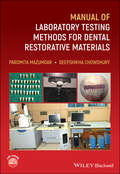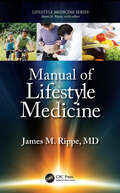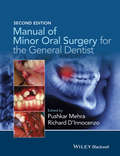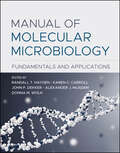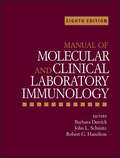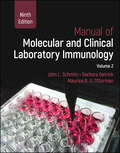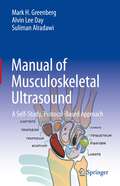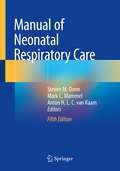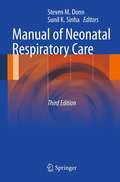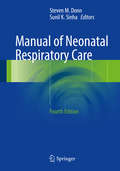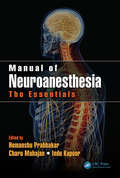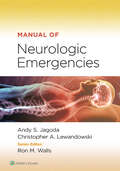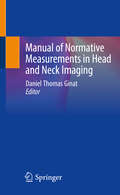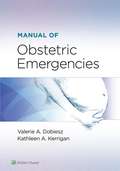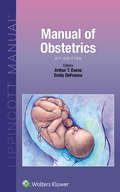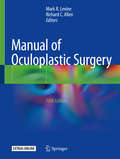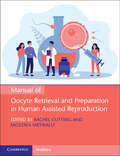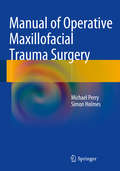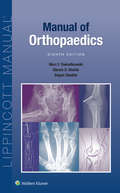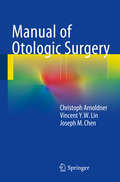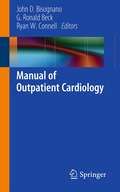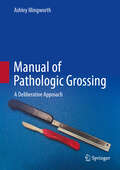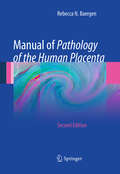- Table View
- List View
Manual of Intrauterine Insemination and Ovulation Induction
by Richard P. Dickey Peter R. Brinsden Roman PyrzakItrauterine insemination and Ovulation induction are effective first-line treatments for infertility in many straightforward cases and are preferred by many clinicians because they are less invasive than in vitro fertilization and its variants. This is a comprehensive account of how to set up and run a successful IUI program.
Manual of Laboratory Testing Methods for Dental Restorative Materials
by Paromita Mazumdar Deepshikha ChowdhuryExplore the properties of a wide range of dental materials used in restorative dentistry with a brand-new resource The Manual of Laboratory Testing Methods for Dental Restorative Materials delivers a comprehensive and accessible review of the materials used in restorative dentistry. The book offers readers an evidence-based application of the materials and their mechanical, physical, and optical properties. Each chapter begins with key points and includes a glossary to aid in the learning and retention of the material contained within. The book also covers the methods used to study the properties and the advantages and disadvantages of various dental restorative materials as well as why they are selected. The Manual of Laboratory Testing Methods for Dental Restorative Materials will be a helpful addition to any institute library or personal collection and will cater to the needs of postgraduate dental students, researchers and academics in the fields of dentistry and material sciences.
Manual of Lifestyle Medicine (Lifestyle Medicine)
by James M. RippeThe fundamental premise of lifestyle medicine is that daily habits profoundly impact health and quality of life both in the short-term and long-term. Written by lifestyle medicine pioneer and cardiologist , Dr. James Rippe, this book provides a clinically oriented, evidence-based look into key lifestyle factors and how to prescribe them to individuals of all ages. Written for professionals working at all levels of medical and healthcare practice, this manual summarizes the major components of lifestyle medicine, from physical activity and nutrition to weight management and the avoidance of tobacco products. It includes clinical guidelines and practices for using lifestyle medicine principles to lower the risk of numerous chronic conditions. The manual also provides information on behavior change, approaches to lowering the risk of dementia, treatment of addictions and injury prevention. Features: Explains how lifestyle medicine can reduce the risk of heart disease, diabetes, cancer, osteoarthritis, dementia and many other chronic conditions. Chapters begin with bulleted key points and conclude with a list of clinical applications. Provides strategies for prescribing physical activity and helping patients improve their nutrition, lose weight if necessary and reduce stress. Includes clinically relevant sections on “Treating Addiction, Preventing Injury and Improving Brain Health”. This book provides updated and clinically targeted summaries used in conjunction with Dr. Rippe's major academic textbook Lifestyle Medicine, now in its third edition, published by CRC Press/Taylor & Francis Group, LLC.
Manual of Minor Oral Surgery for the General Dentist
by Pushkar Mehra Richard D'InnocenzoThe Manual of Minor Oral Surgery for the General Dentist, Second Edition continues the aim of providing clear and practical guidance to common surgical procedures encountered in general practice. Fully revised and updated with three additional chapters, the book approaches each procedure through detailed, step-by-step description and illustration. Ideal for general dental practitioners and students, the book is an indispensible tool for planning, performing, and evaluating a range of surgical procedures in day-to-day practice. The Manual of Minor Oral Surgery for the General Dentist begins with an expanded chapter on patient evaluation and history taking and a new chapter on managing the patient with medical comorbidities. It also address infections and sedation besides procedural chapters on such topics as third molar extractions, preprosthetic surgery, surgical implantology, crown-lengthening, and biopsy of oral lesions.
Manual of Molecular Microbiology: Fundamentals and Applications (ASM Books)
by Karen C. Carroll Randall T. Hayden Donna M. Wolk John P. Dekker Alexander J. McADAMYour essential guide to design, operation, management, and health care integration of the modern molecular microbiology laboratory This comprehensive resource offers definitive guidance on the operational and interpretive aspects of clinical molecular microbiology. Tailored for medical laboratory professionals, it provides practical “how-to” guidance for establishing, maintaining, and advancing molecular microbiology testing services and details the unique expertise required to support infectious disease diagnostics. The Manual offers a clear and practical roadmap for topics ranging from selecting appropriate technologies, instruments, and analytic pipelines to navigating complex interpretive challenges and positioning diagnostic testing services for future clinical and population health needs. Beginning with foundational technologies and their clinical applications, this book offers accessible overviews of each method’s potential, implications, and emerging roles. Subsequent sections dive meticulously into details of laboratory setup, design, and operations, empowering readers with hands-on insights for routine and advanced testing methods, including advanced sequencing technologies. It also tackles the nuanced challenges of interpreting and reporting results from cutting-edge diagnostics, including those focused on antimicrobial resistance and metagenomics. The final section explores the broader impact of molecular microbiology on value-based care, with discussions on clinical management, laboratory stewardship, and the future of molecular diagnostics in public health. Comprehensive and forward-looking, the Manual of Molecular Microbiology equips readers with both foundational knowledge and practical expertise, making it an indispensable reference for today’s clinical laboratory professionals.
Manual of Molecular and Clinical Laboratory Immunology (ASM Books)
by Barbara Detrick John Schmitz Robert HamiltonTHE authoritative guide for clinical laboratory immunology For over 40 years the Manual of Molecular and Clinical Laboratory Immunology has served as the premier guide for the clinical immunology laboratory. From basic serology testing to the present wide range of molecular analyses, the Manual has reflected the exponential growth in the field of immunology over the past decades. This eighth edition reflects the latest advances and developments in the diagnosis and treatment of patients with infectious and immune-mediated disorders. The Manual features detailed descriptions of general and specific methodologies, placing special focus on the interpretation of laboratory findings, and covers the immunology of infectious diseases, including specific pathogens, as well as the full range of autoimmune and immunodeficiency diseases, cancer, and transplantation. Written to guide the laboratory director, the Manual will also appeal to other laboratory scientists, especially those working in clinical immunology laboratories, and pathologists. It is also a useful reference for physicians, mid-level providers, medical students, and allied health students with an interest in the role that immunology plays in the clinical laboratory.
Manual of Molecular and Clinical Laboratory Immunology: 2 Volume Set (ASM Books)
by Barbara Detrick John L. Schmitz Maurice R. G. O’GormanTHE authoritative guide for clinical laboratory immunology For nearly 50 years, the Manual of Molecular and Clinical Laboratory Immunology has been the premier resource for laboratories, students, and professionals involved in the clinical and technical details of diagnostic immunology testing. The 9th Edition continues its tradition of providing comprehensive clinical and technical information on the latest technologies used in medical and diagnostic immunology. Led by a world-renowned group of authors and editors, this new edition reflects substantial changes aimed at improving and updating the Manual’s utility while reflecting the significant transformations that have occurred since the last edition, including the revolution of gene editing and the widespread adoption of molecularly engineered cellular therapies. Topical highlights include: Laboratory Management: three new chapters cover essential aspects of quality assurance, quality improvement, and quality management, aligning with the increasingly stringent and demanding regulatory environment.Inborn Errors of Immunity: the primary immunodeficiency section has been completely updated to align with the latest International Union of Immunological Societies’ classifications of inborn errors of immunity.Functional Cellular Assays: expanded content includes detailed discussions on various functional assays critical for modern immunologic testing.Autoimmune Diseases: expanded chapters on systemic and organ-specific autoimmune disorders, including new chapters on Sjögren’s syndrome and deficiency of ADA2, as well as significant updates on organ-specific autoimmune diseases.Transplantation Immunology: updated chapters detail the assessment of immune reconstitution and ABO testing, reflecting latest practices. The 9th Edition of the Manual of Molecular and Clinical Laboratory Immunology serves as an invaluable resource for laboratory directors, clinicians, laboratory managers, technologists, and students. It provides critical insights into the selection, application, and interpretation of immunologic tests, offering practical guidance on troubleshooting, clinical application, and an understanding of test limitations. This comprehensive and up-to-date manual remains an essential tool for anyone involved in the diagnosis, evaluation, and management of immune-mediated and immune system-related disorders.
Manual of Musculoskeletal Ultrasound: A Self-Study, Protocol-Based Approach
by Mark H. Greenberg Alvin Lee Day Suliman AlradawiThis book is a quick start guide that equips students and professionals with musculoskeletal ultrasound image acquisition basics. Written in plain language, it focuses on the common, clinically relevant conditions diagnosable by musculoskeletal ultrasound. With many verbal and illustrative mnemonics, images, and whimsical illustrations, the manual provides many different methods to remember complicated anatomy and examination protocols. Manual of Musculoskeletal Ultrasound teaches a protocol-based approach designed to help people understand why and how we perform musculoskeletal ultrasound studies. Each chapter covers a different body part and starts with basic anatomy and the clinical questions we want an ultrasound examination of that body part to answer. The protocols within each chapter tell the student precisely how and where to move the probe to obtain and optimize images. It demonstrates what a normal sonographic image should look like and explains what dynamic or structural issues would be abnormal in certain clinical circumstances. The protocol is a checklist that can be practiced on a partner or the reader themself. Chapters also discuss pathologic entities discernable on ultrasound, pitfalls to avoid, and imaging tricks of the trade. This manual is invaluable for students and practicing clinicians in rheumatology, orthopedics, physiatry, neurology, sports medicine, advanced practice, and sonography.
Manual of Neonatal Respiratory Care
by Steven M. Donn Mark C. Mammel Anton H. L. C. van KaamRespiratory care is the largest overall component of neonatal intensive care, and the fifth edition of the Manual of Neonatal Respiratory Care is the leading bedside guide for all aspects of respiratory care in the neonatal intensive care unit. Its easy-to-read outline format is simple yet comprehensive and covers all aspects of lung disease in the newborn infant, including embryology, principles of mechanical ventilation, procedures and techniques, monitoring, devices, adjunctive therapies, management of respiratory illness, complications, outcomes, and related issues. The latest edition includes fully revised and updated information, coverage on new equipment and devices, and an expanded authorship to enhance its international appeal. The new edition also features two new co-editors, Dr. Mark Mammel and Dr. Anton Van Kaam, internationally recognized experts in the field who bring a fresh perspective to the manual. Divided into sixteen sections, the book begins with a section on lung development and maldevelopment, specifically covering the development of the respiratory system, malformations, deformations, disorders of the neonatal airway, and developmental lung anomalies. The second section reviews the principles of mechanical ventilation, with coverage on such topics as spontaneous breathing, oxygen therapy, oxygen toxicity, pulmonary mechanics, and ventilator parameters. The third section of the manual outlines procedures and techniques, including neonatal resuscitation, laryngoscopy and endotracheal intubation, and tracheostomy. The following section dives into the monitoring of the ventilated patient, specifically focusing on continuous monitoring techniques, clinical controversies in pulse oximetry, and echocardiography. The next section spotlights noninvasive ventilatory techniques, such as nasal interfaces, humidified high-flow nasal cannula therapy, and sustained inflation. The sixth section of the manual focuses on ventilatory modes and modalities, with coverage on intermittent mandatory ventilation, pressure support ventilation, and pressure control ventilation. The following section segues into high-frequency ventilation, reviewing general concepts, high-frequency jet ventilation, and high-frequency oscillatory ventilation. The eighth section centers around commonly used neonatal ventilators, such as the DRAEGER VN500 ventilator, the AVEA ventilator, and the Twinstream ventilator. The ninth section reviews adjunctive therapies, including hemodynamic support, nutritional support, the use of sedation and analgesia, inhaled nitric oxide therapy, and ECMO. The tenth section shifts gears to spotlight the management of common neonatal respiratory diseases, with chapters on mechanisms of respiratory failure, tissue hypoxia, respiratory distress syndrome, persistent pulmonary hypertension, and pulmonary hypoplasia/agensis among others. Section eleven reviews the etiology, pathogenesis, and management of bronchopulmonary dysplasia, as well as the long-term outcome of newborns with this chronic lung disease. The next section presents complications associated with mechanical ventilation, such as thoracic air leaks, neonatal pulmonary hemorrhage, and neurologic complications. The following two sections spotlights ethical, legal and other considerations, among them nursing care of the ventilated infant, long-term ventilator dependency, home ventilation, withdrawal of ventilatory support, and medical liability and risk management. The fifteenth section focuses on research and literature, with coverage on interpreting medical literature, data collection and assessment of respiratory outcomes, and contemporary classics in neonatal respiratory care. The final section presents ventilatory case studies. The text also features over 300 high-yield radiographic images, figures, tables, and algorithms.
Manual of Neonatal Respiratory Care
by Steven M. Donn Sunil K. SinhaThis popular book covers the "how-to" of the respiratory care of newborns in outline format. It includes case studies for self-review and is illustrated with high quality radiographic images, figures, tables, and algorithms. Written and edited by international experts, the Third Edition is a thorough update and remains a convenient source of practical information on respiratory physiology, exam techniques, tips for performing procedures, radiography, ventilation, pain management, transport, and discharge planning. ·Up-to-date clinical information from world experts ·Case studies ·Easy-to-consult outline format ·Condensed information about all of the major mechanical ventilators (e.g., modes, displays, and alarms) "The extent of coverage, easy readability, superb organization [and] ...practical pearls make [this book] worthwhile...simply a great bargain." --Journal of Perinatology (review of a previous edition)
Manual of Neonatal Respiratory Care
by Steven M. Donn Sunil K. SinhaThe latest edition of this popular book covers the "how-to" of respiratory care of newborns. Chapters from the previous edition have been updated to reflect advances in both equipment and practice, while newer chapters reflect the evolving worldwide approaches to neonatal respiratory failure, such as sustained inflation, optimization of lung volume, and the use of volumetric capnography, aerosol therapy, and management of chylothorax. New additions to the book also include chapters on assessment of large data bases, implementation of quality improvement programs in neonatal respiratory care, chronic ventilation of the baby with non-respiratory failure. The text also features case studies for self-review and is illustrated with high quality radiographic images, figures, tables, and algorithms. Written and edited by international experts, the Manual of Neonatal Respiratory Care, Fourth Edition is a thorough update and remains a convenient source of practical information on respiratory physiology, exam techniques, tips for performing procedures, radiography, ventilation, pain management, transport, and discharge planning.
Manual of Neuroanesthesia: The Essentials
by Hemanshu Prabhakar Charu Mahajan Indu KapoorThis book will provide all the basic details of neuroanaesthesia and how management of different neurosurgical cases may differ. Simple issues such as neurological examination of patient, understanding CT-scan and MRI scans along with anaesthetic management are discussed in simple language, making this book a ready-reckoner. The title provides an insight into all possible aspects of anesthetic management of neurosurgical and commonly encountered neurologic patients. The book also includes chapters related to allied specialities such as critical care, neurology and neuroradiology, making it a complete package.
Manual of Neurologic Emergencies
by Andy S. Jagoda Christopher A. Lewandowski Ron M. WallsBased on the highly-regarded Walls Manual of Emergency Airway Management and part of the Manual of Emergency Medicine series envisioned by leading authority in emergency medicine, Dr. Ron M. Walls, Manual of Neurologic Emergencies provides evidence-based, easy-to-read coverage on the diagnosis and management of neurologic emergencies. Through the direction and expertise of editors Drs. Andy S. Jagoda and Christopher A. Lewandowski, this reference is a practical guide to approaching the patient with a neurologic complaint in a systematic way, providing a hands-on framework for clinical decision making and therapeutic interventions.
Manual of Neurosonology
by Csiba, László and Baracchini, Claudio László Csiba Claudio BaracchiniNeurosonology is non-invasive, portable, and has excellent temporal resolution, making it a valuable and increasingly popular tool for the diagnosis and monitoring of neurological conditions when compared to other imaging techniques. This guide looks beyond the use of neurovascular ultrasound in stroke to encompass a wide range of other neurological diseases and emergencies. It offers a practical approach to the examination of patients, interpretation of ultrasound studies, and the application of neurosonology to the development of management and treatment strategies. Each chapter incorporates a thorough and clear procedural methodology alongside scanning tips for trainees; this step-by-step approach is further enhanced by example images and focused diagnostic questions. Authored and edited by international experts, this practical manual of neurosonology is an invaluable resource for neurologists, neurosurgeons, intensivists, radiologists and ultrasonographers.
Manual of Normative Measurements in Head and Neck Imaging
by Daniel Thomas GinatThis text is a comprehensive reference guide for normative measurements of anatomic structures in the head and neck, including lymph nodes, temporal bone, skull base, craniocervical junction, orbit, tonsillar tissues, thyroid, and salivary glands. The aim is to assist in the accurate interpretation of imaging studies of this region, where the size of different structures is of high importance for the differentiation of normal and abnormal anatomy, taking into account patient age and gender. The book includes illustrated examples of the proper measurement techniques. Furthermore, examples of pathology with abnormal measurements are included for comparison. The Manual of Normative Measurements in Head and Neck Imaging will serve as a valuable asset for radiologists and clinicians who are involved in the evaluation of patients with head and neck disorders.
Manual of Obstetric Emergencies
by Valerie Dobiesz Kathleen KerriganWritten by emergency medicine practitioners for emergency medicine practitioners, Manual of Emergency Medicine Obstetrics provides a practical overview of all trimesters in a convenient manual format. Nearly two dozen expert contributors representing both emergency medicine and obstetrics offer evidence-based treatment and management guidelines for virtually any situation you may encounter, providing a unique emergency medicine perspective on best practices for high-risk, high-stress obstetric situations in the ED.
Manual of Obstetrics (Spiral Manual Ser.)
by Arthur T. Evans Emily DeFrancoWith coverage of all major aspects of obstetric care, Manual of Obstetrics, 9th Edition, is a practical point-of-care reference and review for medical students, ob/gyn residents, fellows, obstetricians, family medicine physicians, and advanced practice nurses. Fully updated from cover to cover, this bestselling manual covers prenatal care, labor and delivery, obstetric complications, medical complications of pregnancy, fetal assessment, fetal diagnosis and therapy, and neonatal care.
Manual of Oculoplastic Surgery
by Mark R. Levine Richard C. AllenFor the last two decades, this best-selling, step-by-step guide to oculoplastic surgery has been highly respected and widely used by ophthalmologists, oculofacial plastic fellows, residents, ENT-facial plastic surgeons, and general plastic surgeons. The revised and updated fifth edition of Manual of Oculoplastic Surgery is designed to guide the physician in exploring and completing a variety of ocular plastic procedures in a comprehensive and logical step-by-step sequence. It features new authors.Sections include: Trauma, Lacrimal Surgery, Cosmetic, Congenital Ptosis, Acquired Ptosis, Eyelid Malposition, Facial Nerve Dysfunction, Eyelid Flaps, Orbital Surgery, and Therapeutic Considerations. Each procedure in this must-have resource includes a review of the surgical anatomy, step-by-step instructions, plus the book is complete with more than one hundred color illustrations and dozens of surgical videos for further education.
Manual of Oocyte Retrieval and Preparation in Human Assisted Reproduction
by Mostafa Metwally Rachel CuttingObtaining good quality oocytes and preparing them for in-vitro fertilization (IVF) is a key stage in assisted reproduction. This is a complex process with many pitfalls, making good clinical preparation and laboratory technique essential for success. Illustrated throughout, this book will be valuable to clinical embryologists, laboratory personnel wishing to redefine or develop technique and improve outcomes, IVF quality managers, and gynecologists performing oocyte retrieval. Featuring descriptions of the underlying science along with practical advice on methods and trouble-shooting, this comprehensive manual will aid all those involved in this complex process of oocyte retrieval and preparation in navigating towards optimal outcomes.
Manual of Operative Maxillofacial Trauma Surgery
by Michael Perry Simon HolmesThis manual is a condensed and didactic "how to" book, demonstrating surgical procedures in a step by step manner. It is fully comprehensive and highly illustrated (in colour, using mostly operative photographs), restricted solely to the surgical management of maxillofacial trauma, but includes most of the surfical approaches and methods of repair for all maxillofacial injuries. By including all surgical procedures (in trauma) this manual will make a useful and portable accompaniment to the Atlas of Operative Maxillofacial Trauma Surgery. It will be a good resource for all trainees, not only in maxillofacial surgery, but also in other related specialties.
Manual of Orthopaedics (Lippincott Manual Series)
by Marc F. SwiontkowskiNow in vibrant full color, Manual of Orthopaedics, Eighth Edition, provides the must-know information you need to diagnose and treat musculoskeletal injuries and diseases with confidence. This quick-reference manual has been completely updated and revised to include content particularly valuable for orthopaedic physician assistants, while retaining key information for orthopaedic residents and nurse practitioners, primary care physicians, and orthopaedic providers in all practice environments.
Manual of Otologic Surgery
by Christoph Arnoldner Vincent Y. W. Lin Joseph M. ChenThis book takes the reader step-by-step through routine temporal bone surgeries while maximizing the use of the cadaver tissue. In an effort to improve visual realism, the book provides high-resolution photographs and anatomically accurate illustrations to allow the reader to better appreciate the three-dimensional relationship of the internal constructs of the temporal bone. Special emphasis is placed on describing the latest techniques for cochlear implantation and active middle ear implants. The book is further enhanced by additional links to edited videos of surgical cases and will therefore serve as a valuable reference guide to otologic surgeons of all experience levels.
Manual of Outpatient Cardiology
by Ryan W. Connell G. Ronald Beck John D. BisognanoPractical, didactic format designed to deliver point-of-care information to practitioners of cardiology. Highly illustrated with schematics and useful clinical figures, this will be an essential reference to all outpatient cardiology procedures.
Manual of Pathologic Grossing: A Deliberative Approach
by Ashley IllingworthThis textbook is a step-by-step, at the bench, real-world approach to grossing a wide variety of surgical cases. Each figure is produced directly from the bench during the grossing process with the associated dictation. These specimens contain the imperfections of real-life cases with ample illustrations drawn by renown medical illustrationist Kyle Cunningham. This book is not a bullet-point list of what to do but rather a step-by-step, illustrated approach to grossing each specimen. This manual can be utilized at the bench with any specimen at any time. Key features include step-by-step photographic documentation of optimal methods for handling gross specimens commonly seen in the pathology laboratory, medical illustrations that highlight key anatomic features, and tips and tricks to produce optimal diagnostic sections for pathologic diagnosis. Each chapter also includes multiple choice questions to help apply the knowledge and skills learned in the readings. This text is not just a reference manual. It is a deliberative teaching manual meant to be taken into the lab and used at the bench providing consultative support. The text is specifically focused on pathology residents learning grossing skills when no one is around to answer questions. Currently, there are four main surgical grossing texts on the market. Those texts contain drawings and characterizations of the perfect organ and a list of sections needed for each specimen. These books do not focus on the methodology for taking the most appropriate sections with a focus on handling imperfect specimens. Manual of Pathologic Grossing is the only text that includes photographs of each step in the grossing process. The photos are accompanied by a step-by-step text of demonstrating how and why each section was taken.
Manual of Pathology of the Human Placenta
by Rebecca N BaergenManual of Pathology of the Human Placenta, Second Edition is a concise, practical manual of placental pathology. While references are made to the more encyclopedic Pathology of the Human Placenta, this Manual is designed as a user-friendly, easy-to-read bench manual that can be used in the grossing room as well as at the microscope. Features of the text include:- A section on the approach to the placental specimen, providing suggestions on what to do, as well as when and how to do it.- Discussion of detailed development and normal histology of all parts of the placenta for those wanting to learn about specific areas of the placenta.- Discussion of placental lesions, disease processes related to the placenta, neoplasms, and trophoblastic lesions. An overview of the legal implications of placental examination and future direction. "Suggestions for Examination and Report" includes key points in gross examination, sectioning, and diagnosis. Suggestions for comments in the surgical pathology report guide the reader in problematic situations or when the diagnosis or diagnostic implications are unclear.An abundance of tables summarize pertinent information and provide easy access to the differential diagnoses of various lesions. Manual of Pathology of the Human Placenta is a must-have reference for every pathologist, resident and pathology assistant.

